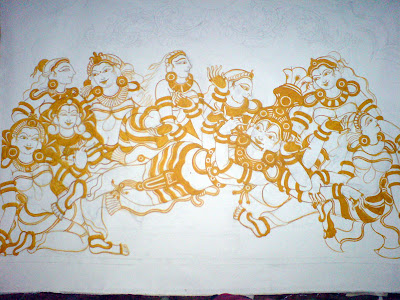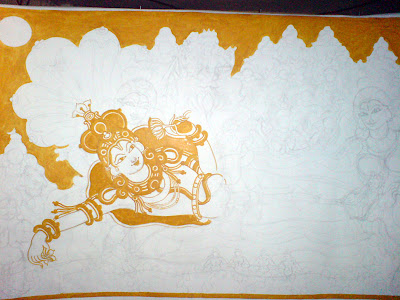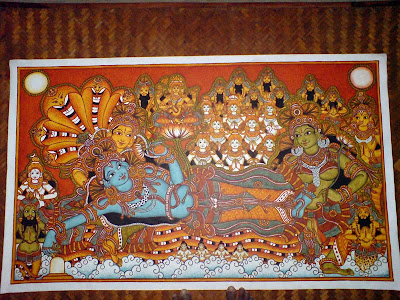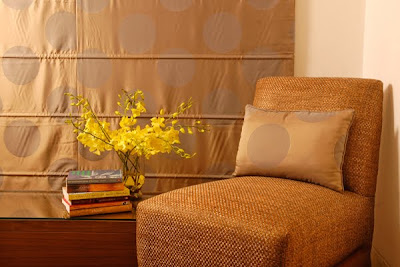Kerala mural paintings are frescos (strictly using naturally available materials), depicting mythology and legends,which are drawn on the walls of temples and churches in Kerala. They stand out for their emphasis on beauty, clarity and symmetry.

Preparation of the walls
The walls have to be first prepared before one does the murals. The walls are given a rough plastering with a mixture of lime and sand, the juice of kadukkai or the juice of a creeper called chunnambuvelli and dissolved jaggery. Then a smooth plaster is applied. The ingredients are the same as in the case of the rough plaster, except that at this stage, cotton is ground together with the other ingredients.
After 10 days, 25 to 30 coats of a mixture of quicklime and tender coconut water are applied. Its features are the lime medium and technique in which the prepared walls are painted only after it gets completely dry.
Colours
Five basic colours are used in mural painting — white, yellow, red, green, and black.
Preparing the colours
For yellow and red, stones such as laterite are ground and the powder is cleaned to remove impurities. The pigment residue is collected and dried.
For green, the leaves of neela amari(Indigofera) are dried and powdered. This powder is bluish in colour. Eruvikkara is a herb whose leaves are crushed to get yellow powder. The blue neela amari powder is mixed with the yellow Eruvikkara to get green, the proportion of the two powders being varied to get different shades.
For black colour wicks are immersed in sesame oil, and then lit. The smoke is collected on the inside of a mud pot. The soot is then carefully scraped out and used where black colour is needed.
The outline is drawn in yellow, and then again in red. The colours are then filled in. Once the painting is finished, the outline is done again in black.
Brushes
Brushes for painting on the wall are made of the blades of certain types of grass and the roots of some trees. Sharpened bamboo pieces are used to draw the outlines of the murals.
Making of Krishna and Gopis
 Sketches are made and yellow is been filled
Sketches are made and yellow is been filled Next comes red
Next comes red
Characters emerge layer by layer,most painstaking process

 After yellow is the turn of green,characters come to the forground with green
After yellow is the turn of green,characters come to the forground with green.jpg) Then comes blue
Then comes blue The gopis begin to take their places,charming and coequittish and full of life
The gopis begin to take their places,charming and coequittish and full of life.jpg) Finally in life like glory
Finally in life like glory
Making of Ananthasayanam,Lord Vishnu



Vishnu Emerges

Lakshmi emerges in yellow
 Still it is Yellow,All characters in yellow
Still it is Yellow,All characters in yellow
Supporting characters emerges

Red emerges
 Central characters becomes red
Central characters becomes red Supporting characters gets their share of red
Supporting characters gets their share of red

Green is the other colour which emerges
 After green comes blue
After green comes blue
 The outlines are filled with black
The outlines are filled with black
 Outlines almost done,image done almost
Outlines almost done,image done almost
 After green comes blue
After green comes blue The outlines are filled with black
The outlines are filled with black Outlines almost done,image done almost
Outlines almost done,image done almost
Image courtesy and Informationcourtesy:aptclasses.com
Image courtesy:keralmurals.in,Artist Naveen,Text:A.Menon















































